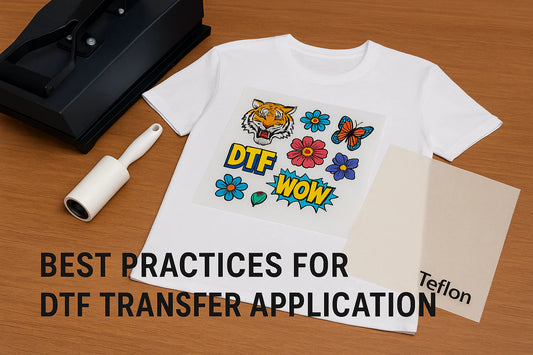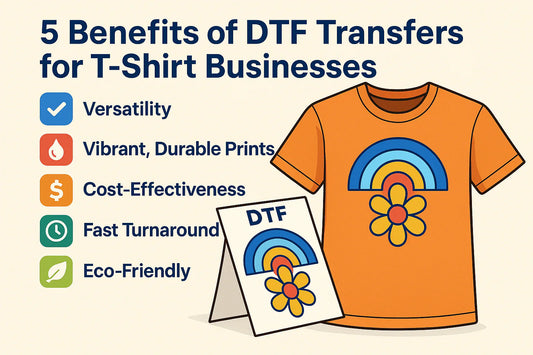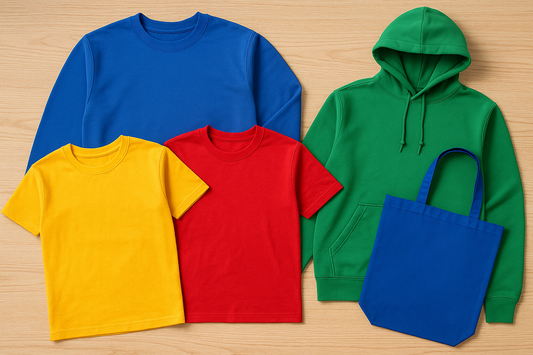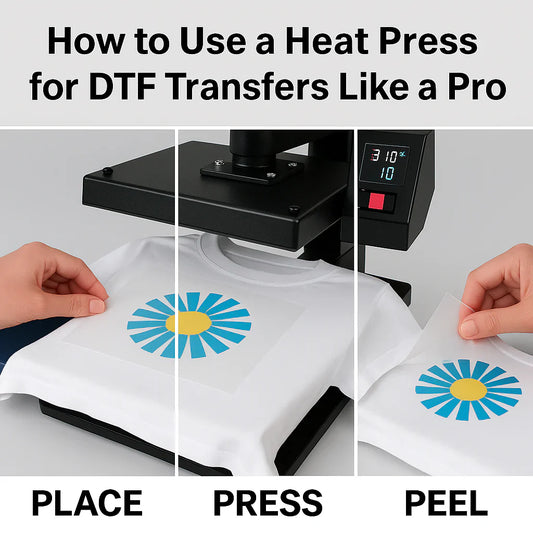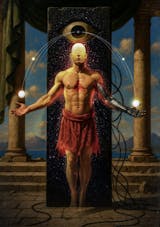Excellent print made t-shirts for some teachers.

Difference Between Screen Print and DTF Printing
Difference Between Screen Print and DTF Printing
In the world of printing, two methods stand out: screen printing and Direct to Film (DTF). Both have their unique strengths and applications, making them popular choices for different projects.
Screen printing, a traditional method, is known for its durability and vibrancy. It's a favorite for large orders due to its cost-effectiveness. However, it requires a significant setup and learning curve.
On the other hand, DTF is a newer technology. It offers detailed prints and the ability to handle custom, one-off designs with ease. Yet, it may not be as cost-effective for large runs.
This guide will delve into the difference between screen print and DTF, comparing their processes, quality, cost, and more. Whether you're a print shop owner, a designer, or a hobbyist, this comparison will help you make an informed decision on the best printing method for your needs.
Understanding Screen Printing
Screen printing is a centuries-old printing method. It involves using a mesh screen to transfer ink onto a substrate, such as fabric. The process is highly versatile and can be used on various materials, including textiles, glass, and wood.
This method is favored for its vibrant color outputs and durability. It's ideal for producing bulk orders, especially in the garment industry. Due to the setup process, it becomes cost-effective when dealing with large quantities.
However, screen printing requires an initial investment in screens and inks. The technique also demands a certain level of skill and experience to achieve high-quality results. Each color in the design needs a separate screen, which can be limiting.
Despite these challenges, screen printing remains a staple in the industry. It offers unrivaled color richness and longevity that keeps its demand high across different sectors.
The Screen Printing Process
The screen printing process starts with creating a stencil. This involves coating a mesh screen with a photosensitive emulsion. The design is then applied, allowing it to harden under light.
Ink is pushed through the stencil with a squeegee, transferring the image to the substrate. Each color layer requires a unique screen, making the process somewhat time-intensive. After printing, the ink is cured or dried to ensure durability.
Pros and Cons of Screen Printing
Screen printing offers many benefits but also has drawbacks.
Pros:
-
Vibrant, long-lasting colors.
-
Cost-effective for large orders.
-
Adaptable to different substrates.
Cons:
-
Lengthy setup time.
-
High initial investment.
-
Limited color variations per design.
While screen printing offers impressive results, its complexities and costs should be considered. For large-scale production, however, it often proves to be the perfect choice.
Exploring DTF (Direct to Film) Printing
Direct to Film (DTF) printing is a modern technique gaining popularity. It involves printing designs directly onto a specialized film. Once printed, the design is transferred onto garments or other substrates.
DTF printing is particularly appreciated for its ease of setup. Unlike screen printing, it doesn’t require screens or lengthy preparation. This makes it a favorable choice for small batches and custom designs.
A notable advantage of DTF is its flexibility with complex designs. It manages color transitions and detailed images with ease, offering high precision. This adaptability makes it appealing to hobbyists and businesses alike.
Despite its advantages, DTF has some limitations. It may not be as cost-effective as screen printing for large volumes. However, its ability to handle intricate designs often outweighs this downside for many users.
The DTF Printing Process
The DTF printing process begins with creating a digital image. This image is printed onto a special film using DTF inks. The inks bond to the film, capturing fine details effectively.
After printing, a powder adhesive is applied to the film. The film is then heat-pressed onto the desired fabric. The heat activates the adhesive, securing the design onto the fabric.
Pros and Cons of DTF Printing
DTF printing has become a revolutionary technique with its own set of benefits and drawbacks.
Pros:
-
Easy setup and minimal preparation.
-
High detail and color accuracy.
-
Suitable for small or custom orders.
Cons:
-
Less cost-efficient for large quantities.
-
Requires specific consumables.
-
Might not be as durable as screen prints.
Overall, DTF is a versatile option for those needing quick turnarounds. It excels in handling detailed and full-color designs, making it a valuable tool in the printing landscape.
Screen Print Transfers vs DTF Transfers
When comparing screen print transfers and DTF transfers, it's important to consider both quality and practicality. Screen print transfers involve printing designs onto transfer paper. These are then heat-pressed onto the fabric. This method has been favored for its enduring quality and ease of use across various materials. DTF transfers, on the other hand, focus on flexibility and detail. They are known for their ability to capture vibrant colors and intricate details. The unique use of film and adhesive in DTF transfers provides a different finish compared to screen printing.
In terms of implementation, both methods have their strengths. Screen print transfers are durable and work well with simple designs. Meanwhile, DTF transfers allow for advanced color palettes and finer details.
The choice between these transfers often depends on your specific needs. Assessing the qualities of each process can help determine the best fit for your project.
Quality and Durability of Transfers
Quality and durability are crucial when choosing a transfer method. Screen print transfers are celebrated for their robust prints. They endure multiple washes without significant fading. This makes them ideal for items expected to see frequent use.
Conversely, DTF transfers shine in color accuracy and detail. While they also offer good durability, especially with proper care, some may find them less lasting over numerous washes. However, their vibrant hues and ability to capture minute details make them a favorite for design-heavy projects.
Cost and Production Efficiency
Cost and production efficiency influence the choice of transfer method significantly. Screen print transfers are generally cost-effective for bulk orders. The setup can be intensive, but it pays off with large-scale production, reducing the overall expense per item.
DTF transfers have a different cost structure. They allow for efficient small-batch production with fewer setup requirements. This makes them a cost-effective choice for custom or limited runs. Despite possibly higher costs per unit for large orders, they offer versatility and speed, suiting dynamic design needs well.
Comparing the Techniques
When considering screen printing and DTF printing, several factors come into play. Each method offers distinct advantages, catering to different needs and preferences. The choice often hinges on the specifics of the design and project scale.
Cost and efficiency are key considerations. Screen printing is traditionally more economical for larger orders. However, DTF allows for quick adjustments and small, customized runs without extensive setup.
Additionally, each technique interacts differently with various fabrics and textures. Understanding these nuances aids in selecting the best method for your specific application needs.
Comparing Screen Print and DTF Printing
| Feature | Screen Printing | DTF Printing |
|---|---|---|
| Setup Time | Long setup; screens needed | Quick; minimal preparation required |
| Cost Efficiency | Best for large orders | Ideal for small or custom orders |
| Color Range | Limited gradients, solid colors | Vibrant gradients and detailed designs |
| Durability | Highly durable, lasts longer | Durable but slightly less than screen |
| Material Compatibility | Mostly cotton and polyester | Works on various materials, including blends and hard surfaces |
Color Vibrancy and Detail
Color vibrancy often dictates the success of a print. Screen printing excels in achieving bold, solid colors that remain vivid over time. However, it may struggle with intricate details or gradients.
DTF printing is known for its exceptional color range and fine detail. This makes it perfect for complex images. The process captures subtle color transitions and finer lines, delivering strikingly accurate results in diverse applications.
Material Versatility and Environmental Impact
Material versatility is critical in selecting a printing method. Screen printing works well on a wide range of fabrics, including cotton and polyester. However, it demands more setup and specific pre-treatment.
DTF printing offers more versatility, efficiently transferring to various materials with minimal preparation. Its environmental impact is generally lower, reducing waste by eliminating excess ink. This makes DTF a suitable choice for eco-conscious projects.
Setup, Learning Curve, and Scalability
The setup and learning curve differ significantly between these techniques. Screen printing requires extensive knowledge of equipment and inks. This can lead to longer setup times and a steeper learning curve for beginners.
In contrast, DTF printing provides a more straightforward setup process. It is user-friendly and suitable for small businesses or hobbyists. Its scalability is advantageous, allowing seamless transitions from small to larger production runs without extensive resource allocation.
Conclusion: Which Method Suits Your Needs?
Choosing between screen printing and DTF depends on your specific goals. Each method excels under different conditions, meeting unique requirements.
Screen printing is ideal for large-scale, vibrant designs on basic fabrics. It delivers durable, cost-effective prints for bulk orders and is perfect for simple color schemes.
Conversely, DTF printing shines in detailed, colorful designs that require versatility. It is well-suited for small batches and varied materials, facilitating flexibility and creativity.
Evaluate your project’s scale and complexity. Carefully considering these factors will guide you to the best printing technique for your needs.
Final Thoughts on Screen Print vs DTF
Both printing methods offer valuable benefits. Screen printing serves traditional needs with robust, lasting prints. It's a reliable choice for bulk orders and timeless designs.
DTF, on the other hand, accommodates modern demands for detail and customization. This method’s flexibility supports unique, high-quality prints.
Ultimately, understanding your project's demands is key. Clear objectives and thoughtful analysis ensure an informed choice that enhances the quality and efficiency of your print work.
Frequently Asked Questions
Many people often ask about the differences and limitations of screen print and DTF. These inquiries focus on fabric compatibility, cost, texture, and environmental impact. Understanding these aspects can assist in making informed printing decisions.
Can I use both techniques on all types of fabric?
DTF is more versatile across fabrics than screen printing, which suits only certain materials.
How do the textures of screen print and DTF transfers compare?
Screen prints feel thicker, while DTF transfers have a softer texture and blend more with the fabric.
Which printing method is more cost-effective for small businesses?
For small runs, DTF is generally more economical due to lower setup costs compared to screen printing.
Is there a difference in print longevity between screen print and DTF?
Screen prints are typically more durable over time, though DTF offers robust quality for detailed designs.
How do screen print and DTF impact the environment?
DTF uses less water and produces fewer emissions, making it slightly more environmentally friendly than screen printing.
For those considering DTF printing, our custom Direct-to-Film services offer unmatched flexibility and precision. Whether you're looking to create vibrant one-off designs or fulfill small-batch orders, we specialize in delivering high-quality prints that meet your exact specifications. From handling complex, intricate designs to providing support in design adjustments, we ensure your project is tailored to perfection. If you'd like to learn more or place an order, feel free to contact our team for personalized assistance. Visit our support page here or call us directly for a consultation. Let us help you make your creative ideas a reality with DTF technology!



